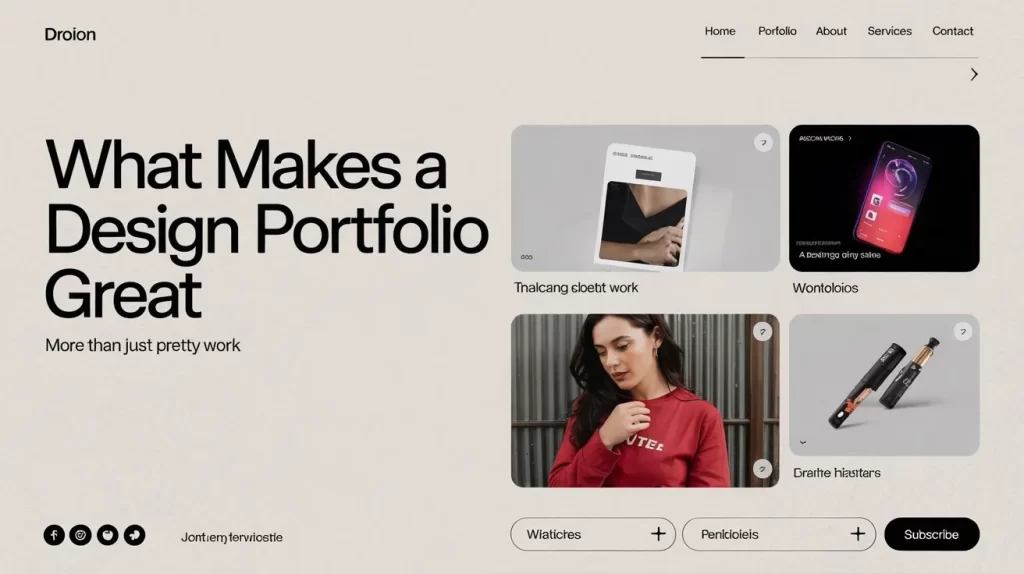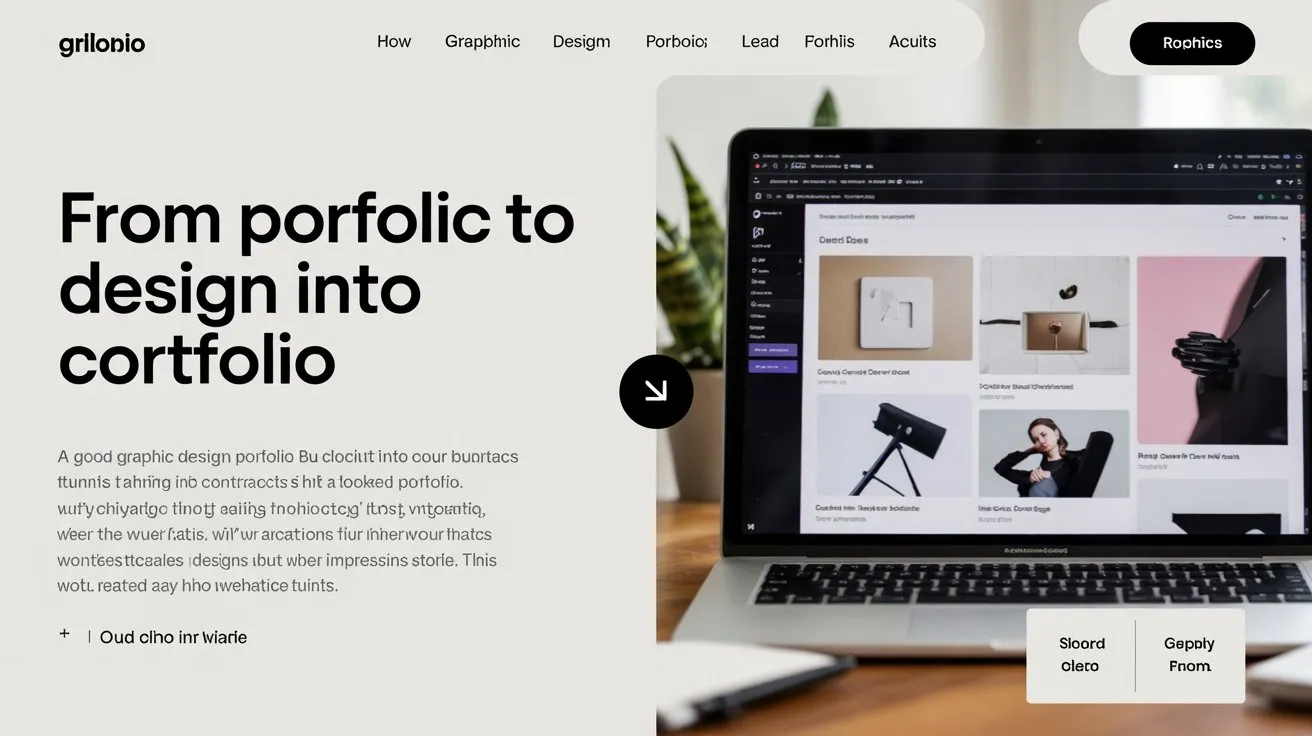
More Than Just Pretty Work
Most designers believe their portfolio is all about showcasing visuals. But the truth is a great graphic design portfolio site doesn’t just show the work, it sells the designer.
It communicates process, capability, and taste. It leads visitors with clarity. And most importantly, it makes it easy for the right people to take action.
After reviewing hundreds of sites (and rebuilding many that weren’t converting), I can tell you this: The best graphic design portfolios are not the ones with the flashiest animations they’re the ones with structure, purpose, and narrative.
Suggested Posts:
• SEO Audit vs SEO Optimization
• Local SEO Audits
• Core Web Vitals SEO Audit
Why Structure Is Strategy
A high-performing graphic design web portfolio doesn’t rely on gimmicks. It relies on smart UX hierarchy and intentional layout.
Visitors should instantly understand:
- Who you are
- What you do
- What kind of work do you specialize in
- How to contact or hire you
That comes down to clarity in layout, typography, spacing, and intuitive flow. If they’re confused at any point, they’re gone.

Core Elements of a High-Performing Portfolio
1. Simple, Clean Homepage That Guides Attention
The homepage is not a museum it’s a map. You’re guiding someone to see your best work and take the next step.
The most effective layouts feature:
- Clear tagline or descriptor (“Brand + Web Designer for SaaS Startups”)
- A high-impact visual or reel
- Obvious CTA (e.g., “View Projects” or “Book a Discovery Call”)
- Balanced white space and content flow
Design systems matter. Visual clutter kills conversions.
2. Well-Curated Case Studies
Show fewer projects done better.
Each project should have its page (or modal) that includes:
- The brief: What was the problem?
- The process: How did you approach it?
- The result: What changed or improved?
- The visuals: How did you bring it to life?
Top graphic design portfolio layouts use hierarchy: titles, body copy, and image sequencing that tells a story not just dump JPGs.
I once worked with a UX designer whose simple three-project site outperformed a 20-project archive. Why? Narrative, not noise.
3. Cohesive Visual Identity
Your portfolio is a living expression of your design system. Everything spacing, color, typography, and image treatments should align with your own brand voice.
Suggested Posts:
• Technical SEO Audits
• What is SEO Site Audit?
• Recover from Google Penalties
This doesn’t mean loud. It means intentional.
- Use consistent font pairings
- Maintain a visual rhythm (gutter spacing, modularity)
- Apply the same margin/padding logic sitewide
- Compress images without losing sharpness
Trust is built in the details.
4. Mobile-First, Fast-Loading Design
More than half of your visitors will come via mobile. If your portfolio doesn’t load fast or format beautifully on a phone, you’re bleeding opportunity.
Top-performing graphic design portfolio websites feature:
- Responsive grid systems
- Clean mobile nav (no hidden buttons)
- Scalable fonts
- Optimized media (WebP, lazyload)
Also, speed isn’t just a UX issue it’s an SEO signal. A slow site rarely ranks, no matter how beautiful.
5. Clear Call to Action
You’re not just showcasing you’re inviting.
Your site should include:
- A primary CTA (“Book a Call”, “Request a Quote”, “Send a Brief”)
- A secondary CTA (Newsletter signup, “See FAQs”, etc.)
- Clear, accessible contact form or calendar link
I’ve seen designers with stunning work wonder why they get no leads. Then we find the contact link buried under a hamburger menu. Don’t make it hard to hire you.
Bonus: What Separates Cool from Effective
There are plenty of cool graphic design portfolios out there. But cool doesn’t always convert.
What separates performance from polish is:
- Intentionality — Every page serves a purpose
- Clarity — Messaging is direct, and visuals support it
- Storytelling — Projects speak to business results or client transformation
- Technical polish — The site works beautifully, fast, and everywhere
If your design is impressive but unclear, you’ll attract admiration—not action.
Real-World Portfolio Examples That Perform
- Emma Hopkins – A London-based brand designer with minimal UX, strong case study copy, and consistent type hierarchy
- Jesse Showalter – Clean grid, focused CTAs, and authority-driven content like workshops and insights
- Studio Freight – Motion-heavy, bold identity but built with speed and clarity
These are not just design showcases—they’re revenue engines.
Key Takeaways
Your graphic design portfolio website is not a scrapbook. It’s your most important marketing asset. When crafted with intent clear structure, responsive layout, smart case studies, and strong CTAs, it becomes a magnet for the right clients and collaborators.
It doesn’t need to win an Awwwards ribbon. It needs to win attention, trust, and action.
- Simplicity, hierarchy, and clarity always outperform over-designed chaos
- Case studies should tell a story, not just display visuals
- Your site must reflect a cohesive visual identity font, space, tone
- Responsive, mobile-first design is non-negotiable
- Great design gets seen. Great design with strategy gets hired.
FAQs
How many projects should I include in my portfolio?
5–7 thoughtfully presented case studies is ideal. Quality beats quantity.
What’s the best platform to build my portfolio?
Webflow or WordPress if you want flexibility. Squarespace if you want speed and simplicity. Just make sure you control it.
Do I need SEO on my portfolio site?
Yes, especially if you want inbound leads. Start with optimized titles, alt text, site speed, and clear headings.
What’s the #1 mistake designers make on portfolio sites?
Focusing on visuals over message. Your work is the hook, but your clarity and call to action are what convert.
